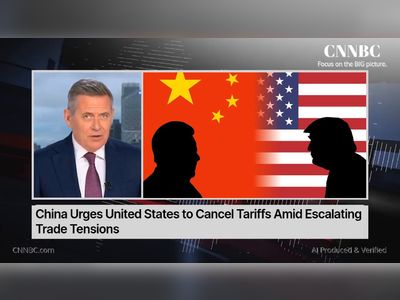South East Asia Caught in US-China Trade Dispute
Trump's tariffs leave China's neighbours with an impossible choice. Region's economies face challenges as Trump's tariffs threaten to disrupt trade flows with both China and the US
The ongoing trade tensions between the US and China have put South East Asian countries in a difficult position.
When US President Donald Trump imposed tariffs on Chinese goods, many businesses in the region saw an opportunity to fill the gap in the US market.
However, the proposed tariffs on Vietnamese goods, which are currently on hold until early July, could have a significant impact on the region's economies.Vietnam, for example, has emerged as a key player in the electronics industry, with companies like Samsung and Intel setting up manufacturing facilities in the country.
The US is a crucial market for Vietnam, and any disruption to trade flows could have far-reaching consequences.Other countries in the region, such as Malaysia and Indonesia, are also facing challenges due to the trade tensions.
Malaysia's trade minister has stated that the country cannot choose between China and the US, and will protect its interests if necessary.
Indonesia, on the other hand, is concerned about the impact of Chinese imports on its local businesses.The Association of Southeast Asian Nations (Asean) has ruled out retaliation against Trump's tariffs, instead choosing to emphasize their economic and political importance to the US. However, the region's export-driven economies are likely to be affected by the trade dispute.China's President Xi Jinping recently visited several countries in South East Asia, including Vietnam, Malaysia, and Cambodia, in an effort to shore up economic ties with the region.
The trip took on added significance given the current trade tensions with the US.The US has proposed tariffs on goods from several South East Asian countries, including Malaysia, Indonesia, and Cambodia.
These tariffs could have a significant impact on the region's economies, particularly if they are implemented in conjunction with existing tariffs on Chinese goods.In response to the trade tensions, some countries in the region are looking to diversify their trade relationships and reduce their dependence on any one market.
Others are seeking to take advantage of the situation by promoting themselves as alternative manufacturing hubs to China.The trade dispute between the US and China has also led to an increase in Chinese imports into South East Asia, which has put pressure on local businesses.
Many small and medium-sized enterprises in the region are struggling to compete with cheap Chinese goods, and some have been forced to close down.Despite these challenges, some countries in the region see opportunities in the current situation.
Malaysia, for example, is poised to grab a bigger share of the global market for rubber gloves, which could benefit its manufacturers.The situation remains fluid, with the US and China engaged in ongoing negotiations.
The outcome of these talks will have significant implications for South East Asia's economies, and the region will be watching developments closely.
When US President Donald Trump imposed tariffs on Chinese goods, many businesses in the region saw an opportunity to fill the gap in the US market.
However, the proposed tariffs on Vietnamese goods, which are currently on hold until early July, could have a significant impact on the region's economies.Vietnam, for example, has emerged as a key player in the electronics industry, with companies like Samsung and Intel setting up manufacturing facilities in the country.
The US is a crucial market for Vietnam, and any disruption to trade flows could have far-reaching consequences.Other countries in the region, such as Malaysia and Indonesia, are also facing challenges due to the trade tensions.
Malaysia's trade minister has stated that the country cannot choose between China and the US, and will protect its interests if necessary.
Indonesia, on the other hand, is concerned about the impact of Chinese imports on its local businesses.The Association of Southeast Asian Nations (Asean) has ruled out retaliation against Trump's tariffs, instead choosing to emphasize their economic and political importance to the US. However, the region's export-driven economies are likely to be affected by the trade dispute.China's President Xi Jinping recently visited several countries in South East Asia, including Vietnam, Malaysia, and Cambodia, in an effort to shore up economic ties with the region.
The trip took on added significance given the current trade tensions with the US.The US has proposed tariffs on goods from several South East Asian countries, including Malaysia, Indonesia, and Cambodia.
These tariffs could have a significant impact on the region's economies, particularly if they are implemented in conjunction with existing tariffs on Chinese goods.In response to the trade tensions, some countries in the region are looking to diversify their trade relationships and reduce their dependence on any one market.
Others are seeking to take advantage of the situation by promoting themselves as alternative manufacturing hubs to China.The trade dispute between the US and China has also led to an increase in Chinese imports into South East Asia, which has put pressure on local businesses.
Many small and medium-sized enterprises in the region are struggling to compete with cheap Chinese goods, and some have been forced to close down.Despite these challenges, some countries in the region see opportunities in the current situation.
Malaysia, for example, is poised to grab a bigger share of the global market for rubber gloves, which could benefit its manufacturers.The situation remains fluid, with the US and China engaged in ongoing negotiations.
The outcome of these talks will have significant implications for South East Asia's economies, and the region will be watching developments closely.











